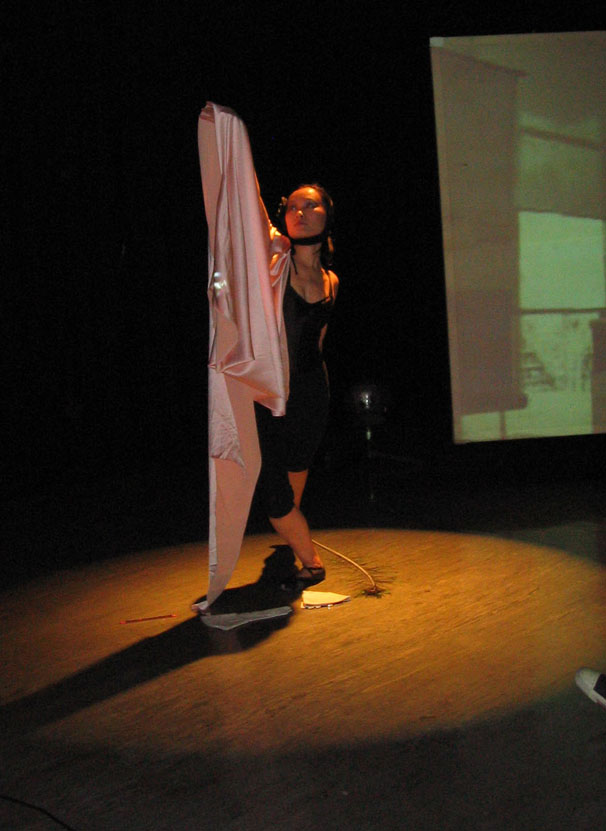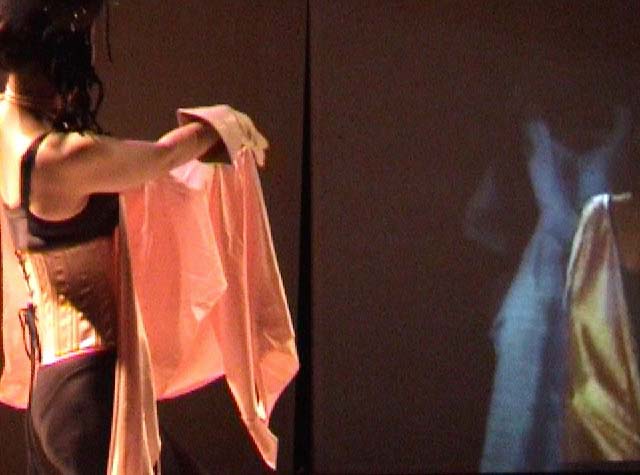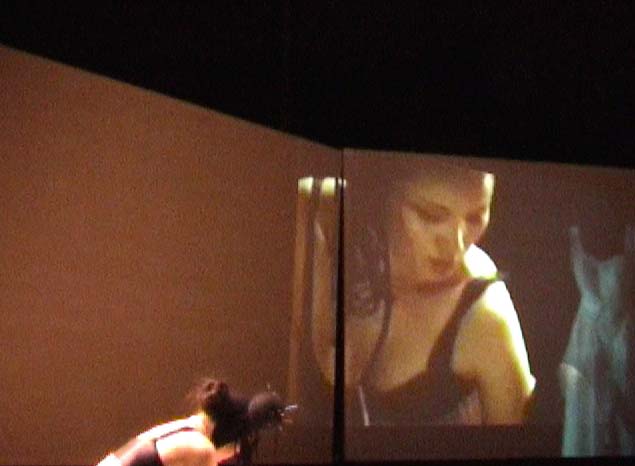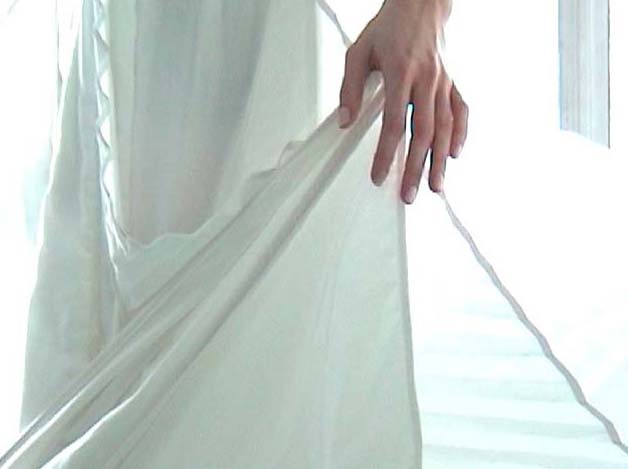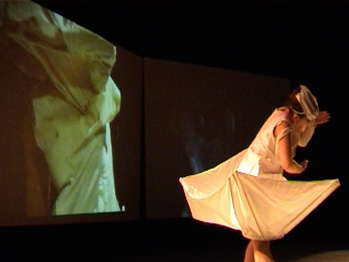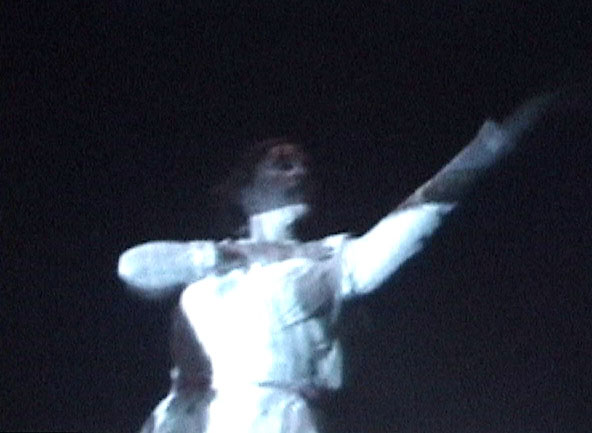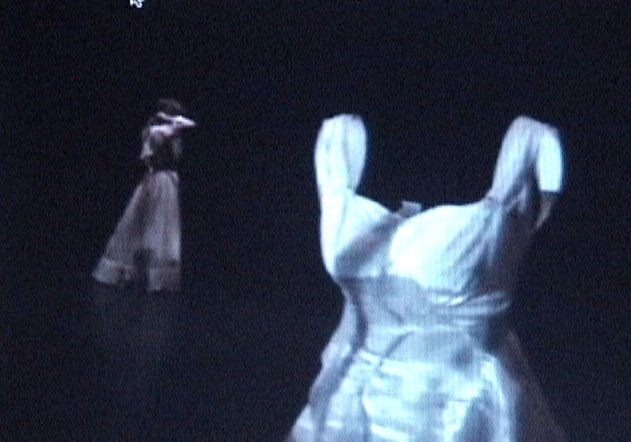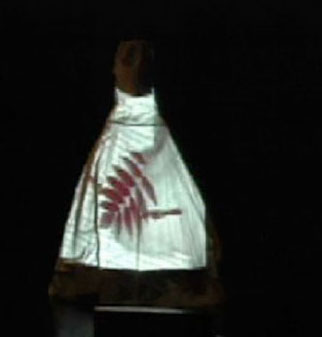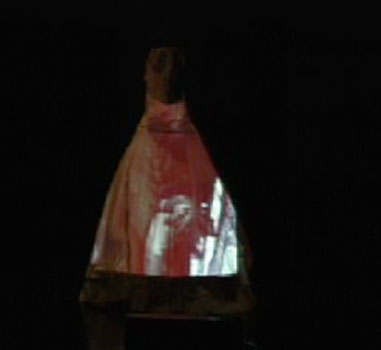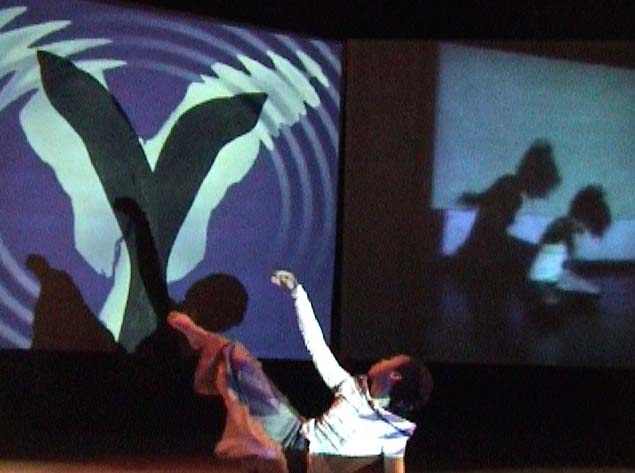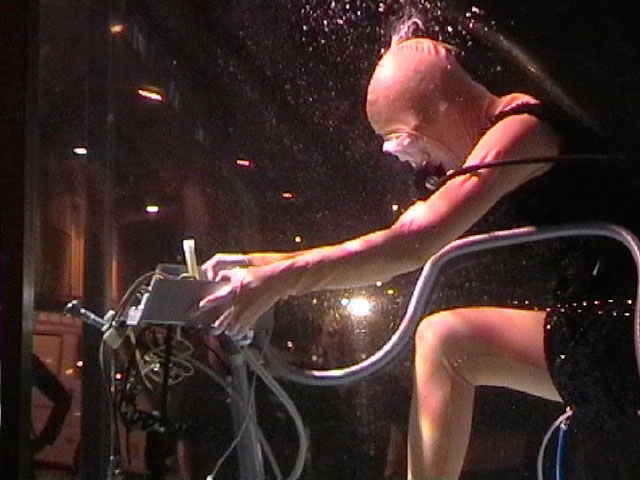Design And Performance Lab
|
The Telematic Dress:
(c) 2005
Abstract Centered around several short films from streaming performances created in 2005, this paper explores new ideas for movement technologies and garment design in an arts and digital research context. The "telematic dress" project, developed at the DAP Lab in Nottingham, involves transdisciplinary intersections between fashion and live performance, interactive system architecture, electronic textiles, wearable technologies, choreography, and anthropology. The concept on an evolving garment design that is materialized (moved) in live performance originates from DAP Lab's experimentation with telematics and distributed media (http://www.brunel.ac.uk/dap.htm] addressing "connective tissues" through a study of perception/proprioception in the wearer (tactile sensory processing) and the dancer/designer/viewer relationship. This study is conducted as cross-cultural communication with online performance partners in Europe, the US, Brazil and Japan. The inter-active space is predicated on transcultural questions: how does the movement with an evolving design and wearable interactive sensors travel, how does movement - and capturing of movement - allow the design to emerge toward a garment statement, and how are bodies-in-relation-to sensory fabrics affected by the multidimensional kinesthetics of a media-rich, responsive environment.
The telematic dress is a conceptual prototype developed through and for performance and tested in the responsive multi-media environment of a telematics studio in Nottingham linked to partner sites in Italy, the US, Japan, and Brazil. The concept envisions a partial or fragmentary design that is to emerge and extend all static textile elements in performance between at least two users whose movements, captured and transmitted by cameras, combine to reveal a garment statement. Such garment composition, however, is not only participatory, it also involves sensory elements of wearable computing which are to be postdesigned (edited) in accordance with the adaptive process created by the wearers of the communicational "telematic dress." The research therefore also involves a complementary performance aspect which relates to questions of sensory perception, behavior analysis and cognitive processing. It also involves a transcultural collaboration between artists and designers in different countries collaborating on shareable clothing and digital fashion capable of integrating diverse influences. Our notion of intelligent fashion thus refers primarily to movement, cultural expression in a broad range of performative situations, and the sensory experience of the wearers' bodies in relation to garments which are not "set." In a playful sense, one could also say it refers to garments which are virtual. The practice of the DAP Lab, its manner of transdisciplinary organization and design research connecting professional practitioners and students from multiple backgrounds (fashion and textile design, performance, dance, interactive system architecture, wearable technologies, choreography, photography, film, and anthropology), is committed to expanding as well as questioning the boundaries of artistic production with technology. Its organizational method forms a "collaborative culture" within a dynamic system of interaction between partners, in the sense in which Sher Doruff (2003) describes distributed real-time interaction strategies and fluid negotiations for data sharing and processing as a paradigm for contemporary social networks of collaboration and synchronous co-creation.
The wearable as interactive system Our team emerged from initial telematics workshops which linked the DAP Lab in Nottingham to partner sites of the ADAPT group (Association of Dance and Performance Telematics) whose collaborators work together on experiments in distributed choreography linking sites in Europe, the USA, Brazil and Japan. From these first workshops in "physical camera" and telematic performance, the current Design and Performance Lab emerged with a special focus on including particular "wearables" in the streaming performance experience. Our notion of wearables is two-fold: (1) the first stage of the creative process involves working with cloth and partial design/states of existence (fragments such as the sleeve, headpiece, veil, manipulative shapes and materials, accoutrements), techniques of positive and negative cutting, sensual textures, colors and shared concept. It employs collaborative methods of design development, paying particular attention to the body's movement in relation to the fragmentary elements and how they can be composed in performance and telematic mediation with a remote partner. The responses of the dancers (and camera) begin to externalize the design possibilities and activate the potential routes forward for the design of the "telematic dress."
Helenna with "tedr" (phase 1) The becoming dress - sensual exploration of fabric (2) the second stage posits a closer investigation of textile electronics and soft technologies within interactive and tele-immersive systems, locating the "textile" as an emergent participatory process in the relationship between human performers, i.e. in the interactive scenario of communicational encounters whose mutually transforming sensory boundaries are affected by gesture, action, and other (non-human) agencies such as machines, ambience, climate and digital materials. Such an understanding of textiles makes the wearable a more expansive component in a dynamic environment which includes digital media and wireless communication systems. We explore the conceptual and aesthetic possibilities of an "open," "distributed" dress that is evolving and shareable in the generation of its design by performers and users in different sites across time difference and cultural geographies. This notion of a shareable wearable also implies considering future design to be both participatory and bespoke: emergent design with textile-modules and electronic fabrics functions in such a manner that manufactured building blocks and individualized form are manipulated by the user and allow for flexible protection and support of aesthetic expression in different kinds of interaction with the environment. "Generation" is linked to communication: the new prototype is both personal and interactive, the experience of wearing is touching the other and being touched/wearing touch (cf. Gaines, 2000; Marks, 2002; Birringer, 2004b; 2005). The physiological and affective dimension of this touch is at the foreground of our interest, as we are less concerned with semiotic and informatic levels of interactivity but with affective and erotic qualities or freedoms that arise from restriction, as it was tested in a joint performance between a dancer in a corset (Helenna Ren, Nottingham) and a dancer in a Victorian hoop dress (Keira Hart, Arizona).
In the following, we briefly describe the stages of prototyping in our current work which links the design interests of the fashion artists with the choreographers' and dancers' interest in developing collaborative modes of performance online/across distance and composing and communicating live with streaming or mobile media where images act upon the physical and kinetic experience of the receiver. Reception shapes. The prototypes currently employed in an artistic context will show how such evolving garments and wearable technologies offer various other interactional and communicational possibilities that address a much wider spectrum of social use and industrial application in markets ranging from leisure, entertainment, workwear, sports, healthcare and therapeutic contexts to medical and scientific research contexts. In the autumn of 2005 the "telematic dress" enters research development with computer engineers supported by an industry partnership with CANESIS Ltd. Together with the CANESIS fabrics engineers and their know-how to develop the conductor weave and intelligent cloth, prototyping of phase 2 will move to the point where we can use sensor technology with the fabric to allow transmission of energy/pressure, motion and heat data along with visual/acoustic and text data from site to site via internet or mobile communications allowing wearers in non-proximate locations to exchange expressive gesture and movement across bodies. The DAP lab has not yet worked extensively with sensor and haptic technologies, but prior phenomenological research with the Synaesthesia group in Erfurt (Birringer, 2005), focused on tactile dimensions of visual and sonic media as well as the programming of acoustic interaction. Tactile and kinesthetic-proprioceptive resonances are foregrounded as a system of reference over pure visuality and readability, and this preference influences the choreography and sensory processing with the fabrics.
Helenna Renn with "tedr" (phase 1): The open dress - choreographed texture
The open dress The positive and the negative: existing (together) to create uncanny harmony. Explored through the process of positive and negative cutting, 4m of fabric (yellow silk) create a choreographed texture exploring genesis of an idea/image/garment: the telematic dress begins with the motion of color, with tangible gestures and body rhythms that span more than one body. The streaming media space of this performance becomes a field of visual textures, changing colors, forms, reflections, and sounds (the latter are also generated by the movement through camera tracking), a "resonating space" (Sha/Gill, 2005).
Helenna is touching the women inside Arizona's hoop dress
Two sleeves
(east/west, structured/partially complete/incomplete) and two dancers
Here the initial design (by Jo Cope) affects the way in which the body can move and be energized: the fan or umbrella-like structure generates changing shapes of the body.
Natasha Stott with "puppet dress" These movement behaviors exist, discretely and yet simultaneously, virtually together. There is a small lapse of time between the spaces, as impulses, perceptions of form and touch travel between the dances in distant locations. Within the camera-generated telepresence dialogue, there is also a continuous perturbation of perception, as the local dancer moves with the fabrics in her real time, while Yoon Bo Shim's camera and the software alter the imaging of the shapes in real time to transmit a different body image to the distant sites.
The process of construction/deconstruction of the image/garment is two-fold. The evolving nature of the piece is complex, emerging and adapting in response to the telematic partners and on a more local level to the movements of dancer (who in turn will respond to movements observed in our partners) and capturing technology. Design ideas exist only in partial states of construction, virtually between restriction and fluidity. The unworked cloth (pink wool/silk and yellow silk) becomes adapted into a more revealed piece that momentarily embellishes, shrouds, releases, and re-covers the body in motion. But this body in motion is always also an image regenerated/re-mixed through the digital hyperplasticity of the medium.
Helen Raleigh's film projections on fabric surface
The next phase of this "becoming dress" will have implanted sensors/conductors to detect, monitor and transmit pressure, heat and velocity data. An emergent intelligent garment piece which can be sensed by the woman dancer in Arizona once she experiences a synaesthetic perception of the "biogram" - the audio-visual and tactile transmission which is not real, and not known consciously but felt on the surface as an intense "shared incipiency," as Brian Massumi (2002) has called the eliciting of such proprioceptions. We have observed this quite often in our streaming media performances, namely that the dancers in distributed spaces need not even look at each other on the screens to sense intensive movement, gesture and rhythms in the mediated environment.
The distributed environments resemble the "open dress," as they are liquid/fluid - transvergent, pulsating with sonic disturbances caused by criss-crossing audio streams, and multiperspectival. It is a process of metamorphic design, driven by the dancers' co-presences. Jointly, the textile gestures form an open, unpredictable and evolving system which continuously de-stabilizes, de-materializes. A fusion/hybrid of classical ballet, yoga and martial art provides movement behaviors used to explore/express design. The fabric material requires a ritual of interaction to activate design. For the wearers this implies they to move their bodies to find the design; part of the movement is choreographed, other parts may arise involuntarily through more ordinary or automatic (unconscious) motion and sensorimotor reactions. These textile gestures constitute a sequence of sensate experiences, pre-established stimuli (for design/movement) fused with variable subject-generated stimuli. Such gestural design can be transformed into ritual language gestures, but gestural design at its simplest also becomes complete abstraction. We call these "textile mudras." This co-evolution of design between designer, dancer and viewer invites further consideration of the difference and fluidity between a bespoke piece and a highly responsive environment that affects standard ways of physically relating to the world and the perception of shapes and fabric functions on the sensing body. Choreography is transformed into a sensory kinesthetics that gradually makes a performer become conscious, not only of themselves and the mutable body image, but also how other bodies and media around them effect, shift, and shape the whole environment.
Above all, we are interested in the cultural collaboration between human beings in distant sites, and in the psychological and aesthetic/playful behavior that arises when you have a proposition to wear a dress together or to experience the same dress with energy and sensations transmitted to you by a friend, a partner, a lover, or a playful competitor. Here different cultural and religious contexts play a significant role: Cidinha Fursan Bendixien (Bahia, Brazil) showed us a sequence of gestures in the studio where the energy of the movement specifically relates to one of the orishas in the Yorúba culture. When she moves, the orisha or ancestral spirits move with her, and generally Afro-Brazilian dance also has very strong connotations in the use of color. We treat the "telematic dress" as a communication suit and an extreme fashion statement that you make when you enter into a correspondence that can be deeply spiritual on the one hand, and very playful on the other, as in sports and game modes. The outfit for mobile gaming involves dancing across. The dress can change at every level.
Cidinha dancing in wing-space between mind and body. Simona Pietrosanti (Rome) on the right, with shadow
A further prototype under development is titled "TangoInterface" and refers to the choreography of a dance duet which explores the deeper cultural layers of moving closely together and finding a sensual rhythm that heightens the sexual and erotic resonances of touch. In collaboration with a cognitive scientist from the Medical School at Simon Fraser University (Vancouver), our labs will observe the sensorimotor behavior of tango dancers from a neuroscientific perspective while also emphasizing the "gesture" of the fabric design worn in the erotic/organic dialogue between female and male dancers. The gestures will be analyzed on levels of kinesthetic action, psychoacoustic processing of music and rhythm, and physiological response to restrictive design. Our current explorations show that a typically restrictive design such as the corset is experienced very differently, as an anchor point, when the dance evolves the design to nurture unacknowledged or private fantasies in the wearer. The "tango corset" (fetish piece) and accoutrements (mask, toys, accessories) enable us to link cinematic and erotic projection. The prototype is created for interactive use by wearers who want to explore the fantasy element of play and the creation of different personae.
Life system and subculture bodysuit
Sarah Jane Pell (Australia) performing under water
Several labs
are involved in this collaborative project; Ionat Zurr and Oron Catts
(SymbioticA, University of Western Australia) conduct and record life
support and operational procedures, and direct operations and duties
of care in parallel bioreactor investigations. Our lab participates
in the telepresence operations to test how such performances or gestations
have a telematic presence with audiences, and how transmitted bio data
can be used for further design of the subculture suit as a protective
garment for different habitats. Our focus is on relations between the
human life support and telematic performance systems. In cooperation
with experimental psychologists, we plan to observe and analyze the
performance behavior within such systems in order to provide artistic
and social perspectives on living-mediated rhythms (rhythms science)
that can be monitored and translated into other data and material-digital
objects.
Looking at emergent design and aesthetic manipulation of movement and living systems, the current emphasis on interactivity requires attention to interaction design and the reception of such systems. As a collaborative international research team, we understand our experimentation with textile gestures, communications technology and telematics to open up a broader conception of ecology: we ask how the touch of "gesture" in adaptive/adoptive living process is communicated or felt, and how moveable garments are exploited and sensed by the public or the participants in such media-rich life worlds. In the telematic ambience, performing, broadcasting and simultaneously receiving multiple streams (sonic/video and gestural/tactile information substrates), the emerging environment is a highly complex, dynamic and multisensorial field (Birringer, 2004). Our research on such real/real-time computational environments poses questions about how we focus on gesture, cloth and bodies in sense-making (sensory process/cognititive process), and how we experience a distributed synaesthesia, shared with others. Our approach does not presume a monolithic subject but is ecologically oriented, without losing sight of the human/machine interfaces and the ambivalent role of agency in such interfaces (Jo Cope's design or the "puppet dress" links her research to observation in robotics and intelligent automata behavior). We suggest that such emphasis on intersubjectivity or interagency furthers an understanding of how tactile wearables, emergent garments, emergent interactive bodies, and gestures span multiple bodies, and how aesthetic polydesign inspires the manufacture of intelligent fabrics and soft technologies. From the kinesthetic and proprioceptive experience of "soft movement technologies," the role of gesture and body movement behaviors within today's telecommunications world has broader implications for the use of garments in intimate and sensual communication, and for the integrations of diverse cultural fashions with internal body imaging processes. Furthermore, our observational analysis helps to advance networked multiplayer communications by suggesting responsive play spaces for performance augmented by gesturally nuanced computational media.
Birringer,
J. (2005) "Das Gagarin System/The Gagarin System:
Author Biographies
|
